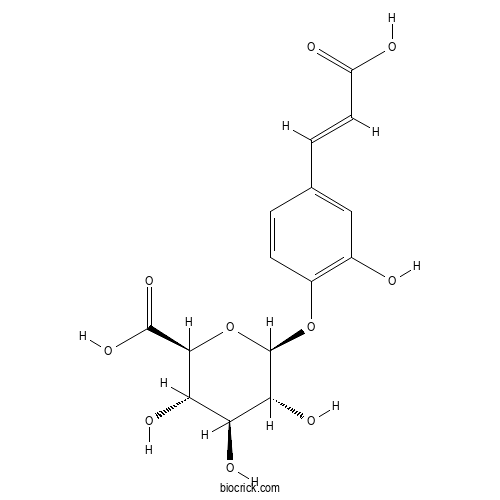Caffeic acid 4-O-glucuronideCAS# 1093679-71-0 |

Quality Control & MSDS
3D structure
Package In Stock
Number of papers citing our products

| Cas No. | 1093679-71-0 | SDF | Download SDF |
| PubChem ID | 25171780 | Appearance | Powder |
| Formula | C15H16O10 | M.Wt | 356.3 |
| Type of Compound | Phenols | Storage | Desiccate at -20°C |
| Solubility | Soluble in Chloroform,Dichloromethane,Ethyl Acetate,DMSO,Acetone,etc. | ||
| Chemical Name | (2S,3S,4S,5R,6S)-6-[4-[(E)-2-carboxyethenyl]-2-hydroxyphenoxy]-3,4,5-trihydroxyoxane-2-carboxylic acid | ||
| SMILES | C1=CC(=C(C=C1C=CC(=O)O)O)OC2C(C(C(C(O2)C(=O)O)O)O)O | ||
| Standard InChIKey | LTGOIJNQWZWJRF-ZYZFHZPYSA-N | ||
| Standard InChI | InChI=1S/C15H16O10/c16-7-5-6(2-4-9(17)18)1-3-8(7)24-15-12(21)10(19)11(20)13(25-15)14(22)23/h1-5,10-13,15-16,19-21H,(H,17,18)(H,22,23)/b4-2+/t10-,11-,12+,13-,15+/m0/s1 | ||
| General tips | For obtaining a higher solubility , please warm the tube at 37 ℃ and shake it in the ultrasonic bath for a while.Stock solution can be stored below -20℃ for several months. We recommend that you prepare and use the solution on the same day. However, if the test schedule requires, the stock solutions can be prepared in advance, and the stock solution must be sealed and stored below -20℃. In general, the stock solution can be kept for several months. Before use, we recommend that you leave the vial at room temperature for at least an hour before opening it. |
||
| About Packaging | 1. The packaging of the product may be reversed during transportation, cause the high purity compounds to adhere to the neck or cap of the vial.Take the vail out of its packaging and shake gently until the compounds fall to the bottom of the vial. 2. For liquid products, please centrifuge at 500xg to gather the liquid to the bottom of the vial. 3. Try to avoid loss or contamination during the experiment. |
||
| Shipping Condition | Packaging according to customer requirements(5mg, 10mg, 20mg and more). Ship via FedEx, DHL, UPS, EMS or other couriers with RT, or blue ice upon request. | ||

Caffeic acid 4-O-glucuronide Dilution Calculator

Caffeic acid 4-O-glucuronide Molarity Calculator
| 1 mg | 5 mg | 10 mg | 20 mg | 25 mg | |
| 1 mM | 2.8066 mL | 14.0331 mL | 28.0662 mL | 56.1325 mL | 70.1656 mL |
| 5 mM | 0.5613 mL | 2.8066 mL | 5.6132 mL | 11.2265 mL | 14.0331 mL |
| 10 mM | 0.2807 mL | 1.4033 mL | 2.8066 mL | 5.6132 mL | 7.0166 mL |
| 50 mM | 0.0561 mL | 0.2807 mL | 0.5613 mL | 1.1226 mL | 1.4033 mL |
| 100 mM | 0.0281 mL | 0.1403 mL | 0.2807 mL | 0.5613 mL | 0.7017 mL |
| * Note: If you are in the process of experiment, it's necessary to make the dilution ratios of the samples. The dilution data above is only for reference. Normally, it's can get a better solubility within lower of Concentrations. | |||||

Calcutta University

University of Minnesota

University of Maryland School of Medicine

University of Illinois at Chicago

The Ohio State University

University of Zurich

Harvard University

Colorado State University

Auburn University

Yale University

Worcester Polytechnic Institute

Washington State University

Stanford University

University of Leipzig

Universidade da Beira Interior

The Institute of Cancer Research

Heidelberg University

University of Amsterdam

University of Auckland

TsingHua University

The University of Michigan

Miami University

DRURY University

Jilin University

Fudan University

Wuhan University

Sun Yat-sen University

Universite de Paris

Deemed University

Auckland University

The University of Tokyo

Korea University
- Tortoside B (Manglieside E)
Catalog No.:BCN0751
CAS No.:190655-17-5
- Mucronulatol
Catalog No.:BCN0750
CAS No.:20878-98-2
- Picraquassioside B
Catalog No.:BCN0749
CAS No.:169312-05-4
- 2,3-Dehydrosilychristin
Catalog No.:BCN0748
CAS No.:57499-41-9
- 10-O-trans-p-Feruloylscandoside
Catalog No.:BCN0747
CAS No.:1428268-72-7
- Sativanone
Catalog No.:BCN0746
CAS No.:70561-31-8
- 3',8-Dihydroxyvestitol
Catalog No.:BCN0745
CAS No.:122587-87-5
- Theaflavanoside II
Catalog No.:BCN0744
CAS No.:943785-09-9
- 5,6,7,3',4',5'-Hexamethoxyflavanone
Catalog No.:BCN0743
CAS No.:74064-17-8
- Cuneataside C
Catalog No.:BCN0742
CAS No.:871720-16-0
- 10-O-trans-p-coumaroylscandoside
Catalog No.:BCN0741
CAS No.:870785-25-4
- Lariciresinol 4-O-glucoside
Catalog No.:BCN0740
CAS No.:143663-00-7
- Ternstroside C
Catalog No.:BCN0760
CAS No.:914649-21-1
- Ternstroside A
Catalog No.:BCN0761
CAS No.:914649-13-1
- Ternstroside B
Catalog No.:BCN0762
CAS No.:914649-16-4
- Ternstroside D
Catalog No.:BCN0764
CAS No.:914649-26-6
- Ternstroside E
Catalog No.:BCN0765
CAS No.:914649-31-3
- Ternstroside F
Catalog No.:BCN0766
CAS No.:914649-36-8
- 5,6,7,3',4'-Pentamethoxyflavanone
Catalog No.:BCN0753
CAS No.:104193-93-3
- Dihydrophaseic acid 4'-O-beta-D-glucopyranoside
Catalog No.:BCN0754
CAS No.:78914-56-4
- Ternatumoside II
Catalog No.:BCN0755
CAS No.:1473419-87-2
- ZP-amide C
Catalog No.:BCN0756
CAS No.:412316-38-2
- Eucomic acid
Catalog No.:BCN0757
CAS No.:42151-32-6
- 7-O-(4-beta-D-glucopyranosyloxy-3-methoxybenzoyl)secologanolic acid
Catalog No.:BCN0758
CAS No.:469899-55-6
Simultaneous Determination of Chlorogenic Acid Isomers and Metabolites in Rat Plasma Using LC-MS/MS and Its Application to A Pharmacokinetic Study Following Oral Administration of Stauntonia Hexaphylla Leaf Extract (YRA-1909) to Rats.[Pubmed:30200538]
Pharmaceutics. 2018 Sep 2;10(3). pii: pharmaceutics10030143.
Stauntonia hexaphylla leaf extract (YRA-1909), which is widely used for the antirheumatic properties, has been under phase 2 clinical trials in patients with rheumatoid arthritis since April 2017. Liquid chromatography-tandem mass spectrometric method while using liquid(-)liquid extraction with ethyl acetate was validated for the simultaneous determination of the major active components of YRA-1909, including chlorogenic acid (CGA), neochlorogenic acid (NCGA), cryptochlorogenic acid (CCGA), and their metabolites (i.e., caffeic acid (CA), caffeic acid 3-O-glucuronide (CA-3-G), Caffeic acid 4-O-glucuronide (CA-4-G), and ferulic acid (FA)) in rat plasma and applied to a pharmacokinetic study of YRA-1909 in rats. Seven analytes were separated on Halo C18 while using gradient elution of formic acid and methanol, and then quantified in selected reaction monitoring mode whle using negative electrospray ionization. Following oral administration of YRA-1909 at doses of 25, 50, and 100 mg/kg to male Sprague-Dawley rats, CGA, NCGA, and CCGA were rapidly absorbed and metabolized to CA, CA-3-G, and CA-4-G. The area under the plasma concentration-time curve (AUClast) of CGA, NCGA, CCGA, and three metabolites linearly increased as the YRA-1909 dose increased. Other pharmacokinetic parameters were comparable among three doses studied. AUClast values for CA, CA-3-G, and CA-4-G exceeded those for CGA, NCGA, and CCGA.


